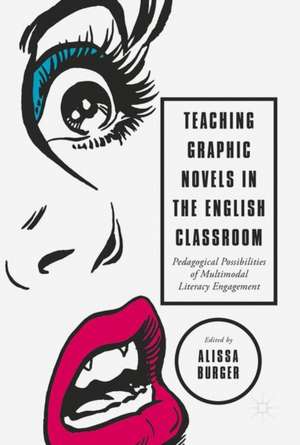Teaching Graphic Novels in the English Classroom: Pedagogical Possibilities of Multimodal Literacy Engagement
Editat de Alissa Burgeren Limba Engleză Hardback – 18 oct 2017
| Toate formatele și edițiile | Preț | Express |
|---|---|---|
| Paperback (1) | 209.56 lei 6-8 săpt. | |
| Springer International Publishing – 18 mai 2018 | 209.56 lei 6-8 săpt. | |
| Hardback (1) | 639.59 lei 6-8 săpt. | |
| Springer International Publishing – 18 oct 2017 | 639.59 lei 6-8 săpt. |
Preț: 639.59 lei
Preț vechi: 752.45 lei
-15% Nou
Puncte Express: 959
Preț estimativ în valută:
122.41€ • 127.46$ • 103.45£
122.41€ • 127.46$ • 103.45£
Carte tipărită la comandă
Livrare economică 11-25 martie
Preluare comenzi: 021 569.72.76
Specificații
ISBN-13: 9783319634586
ISBN-10: 3319634585
Pagini: 192
Ilustrații: VII, 192 p.
Dimensiuni: 148 x 210 x 15 mm
Greutate: 0.4 kg
Ediția:1st ed. 2018
Editura: Springer International Publishing
Colecția Palgrave Macmillan
Locul publicării:Cham, Switzerland
ISBN-10: 3319634585
Pagini: 192
Ilustrații: VII, 192 p.
Dimensiuni: 148 x 210 x 15 mm
Greutate: 0.4 kg
Ediția:1st ed. 2018
Editura: Springer International Publishing
Colecția Palgrave Macmillan
Locul publicării:Cham, Switzerland
Cuprins
1. Introduction.- 2. Not Just Novels: The Pedagogical Possibilities of the Graphic Narrative.- 3. Understanding Rhetoric, Understanding Genre: A Rhetorical Genre Studies Approached Writing Course.- 4. Writing Through Comics.- 5. Teaching the History and Theory of American Comics: 20th Century Graphic Novels as a Complex Literary Genre.- 6. “What is the use of a book … without pictures of conversations?”: Incorporating the Graphic Novel into the University Curriculum.- 7. “Does Doctor Manhattan Think?”: Alan Moore’s The Watchmen and ‘Great Books’ Curriculum in the Early College Setting.- 8. “If He Be Mr. Hyde, We Shall Be Mr. See”: Using Graphic Novels, Comic Books, and the Visual Narrative in the Gothic Literature Classroom.- 9. Teaching March in the Borderlands Between Social Justice and Pop Culture.- 10. Revising the Rhetoric of ‘Boat People’ Through the Interactive Graphic Adaptation of Nam Le’s “The Boat”.- 11. Performative Pedagogies and Performative Texts: Alison Bechdel’s Fun Home as Compositional Model.
Notă biografică
Alissa Burger is Assistant Professor of English and Director of Writing Across the Curriculum at Culver-Stockton College, USA. She teaches courses in research, writing, and literature, including a single-author seminar on Stephen King. She is the author of Teaching Stephen King: Horror, The Supernatural, and New Approaches to Literature.
Textul de pe ultima copertă
This collection highlights the diverse ways comics and graphic novels are used in English and literature classrooms, whether to develop critical thinking or writing skills, paired with a more traditional text, or as literature in their own right. From fictional stories to non-fiction works such as biography/memoir, history, or critical textbooks, graphic narratives provide students a new way to look at the course material and the world around them. Graphic novels have been widely and successfully incorporated into composition and creative writing classes, introductory literature surveys, and upper-level literature seminars, and present unique opportunities for engaging students’ multiple literacies and critical thinking skills, as well as providing a way to connect to the terminology and theoretical framework of the larger disciplines of rhetoric, writing, and literature.
Caracteristici
Emphasizes pedagogical possibilities of multimodal literacy engagement, as well as key terminology and reading strategies to serve as a primer for those interested in incorporating graphic novels into their English classroom for the first time Examines graphic novels as literature, their incorporation in education in general, and the unique benefits of using graphic narratives in teaching writing, rhetoric, and literary analysis Argues that the graphic novel format helps to transform a novel into an artistic artifact, and thus appeals in part to the needs of our distinctly visual age
